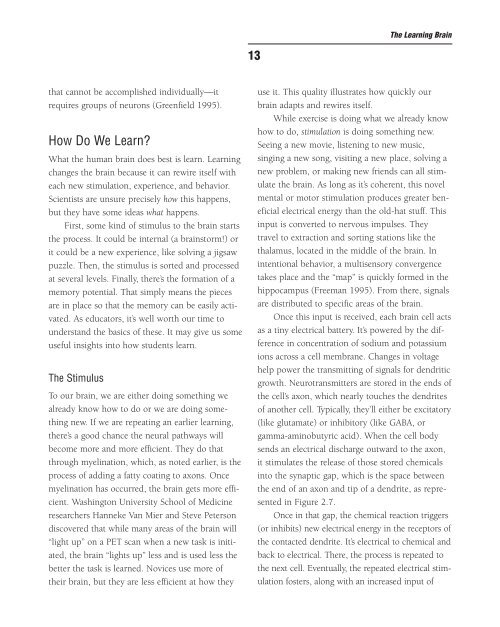You also want an ePaper? Increase the reach of your titles
YUMPU automatically turns print PDFs into web optimized ePapers that Google loves.
that cannot be accomplished <strong>in</strong>dividually—it<br />
requires groups of neurons (Greenfield 1995).<br />
How Do We Learn?<br />
What <strong>the</strong> human bra<strong>in</strong> does best is learn. Learn<strong>in</strong>g<br />
changes <strong>the</strong> bra<strong>in</strong> because it can rewire itself with<br />
each new stimulation, experience, and behavior.<br />
Scientists are unsure precisely how this happens,<br />
but <strong>the</strong>y have some ideas what happens.<br />
First, some k<strong>in</strong>d of stimulus to <strong>the</strong> bra<strong>in</strong> starts<br />
<strong>the</strong> process. It could be <strong>in</strong>ternal (a bra<strong>in</strong>storm!) or<br />
it could be a new experience, like solv<strong>in</strong>g a jigsaw<br />
puzzle. Then, <strong>the</strong> stimulus is sorted and processed<br />
at several levels. F<strong>in</strong>ally, <strong>the</strong>re’s <strong>the</strong> formation of a<br />
memory potential. That simply means <strong>the</strong> pieces<br />
are <strong>in</strong> place so that <strong>the</strong> memory can be easily activated.<br />
As educators, it’s well worth our time to<br />
understand <strong>the</strong> basics of <strong>the</strong>se. It may give us some<br />
useful <strong>in</strong>sights <strong>in</strong>to how students learn.<br />
The Stimulus<br />
To our bra<strong>in</strong>, we are ei<strong>the</strong>r do<strong>in</strong>g someth<strong>in</strong>g we<br />
already know how to do or we are do<strong>in</strong>g someth<strong>in</strong>g<br />
new. If we are repeat<strong>in</strong>g an earlier learn<strong>in</strong>g,<br />
<strong>the</strong>re’s a good chance <strong>the</strong> neural pathways will<br />
become more and more efficient. They do that<br />
through myel<strong>in</strong>ation, which, as noted earlier, is <strong>the</strong><br />
process of add<strong>in</strong>g a fatty coat<strong>in</strong>g to axons. Once<br />
myel<strong>in</strong>ation has occurred, <strong>the</strong> bra<strong>in</strong> gets more efficient.<br />
Wash<strong>in</strong>gton University School of Medic<strong>in</strong>e<br />
researchers Hanneke Van Mier and Steve Peterson<br />
discovered that while many areas of <strong>the</strong> bra<strong>in</strong> will<br />
“light up” on a PET scan when a new task is <strong>in</strong>itiated,<br />
<strong>the</strong> bra<strong>in</strong> “lights up” less and is used less <strong>the</strong><br />
better <strong>the</strong> task is learned. Novices use more of<br />
<strong>the</strong>ir bra<strong>in</strong>, but <strong>the</strong>y are less efficient at how <strong>the</strong>y<br />
13<br />
The Learn<strong>in</strong>g <strong>Bra<strong>in</strong></strong><br />
use it. This quality illustrates how quickly our<br />
bra<strong>in</strong> adapts and rewires itself.<br />
While exercise is do<strong>in</strong>g what we already know<br />
how to do, stimulation is do<strong>in</strong>g someth<strong>in</strong>g new.<br />
See<strong>in</strong>g a new movie, listen<strong>in</strong>g to new music,<br />
s<strong>in</strong>g<strong>in</strong>g a new song, visit<strong>in</strong>g a new place, solv<strong>in</strong>g a<br />
new problem, or mak<strong>in</strong>g new friends can all stimulate<br />
<strong>the</strong> bra<strong>in</strong>. As long as it’s coherent, this novel<br />
mental or motor stimulation produces greater beneficial<br />
electrical energy than <strong>the</strong> old-hat stuff. This<br />
<strong>in</strong>put is converted to nervous impulses. They<br />
travel to extraction and sort<strong>in</strong>g stations like <strong>the</strong><br />
thalamus, located <strong>in</strong> <strong>the</strong> middle of <strong>the</strong> bra<strong>in</strong>. In<br />
<strong>in</strong>tentional behavior, a multisensory convergence<br />
takes place and <strong>the</strong> “map” is quickly formed <strong>in</strong> <strong>the</strong><br />
hippocampus (Freeman 1995). From <strong>the</strong>re, signals<br />
are distributed to specific areas of <strong>the</strong> bra<strong>in</strong>.<br />
Once this <strong>in</strong>put is received, each bra<strong>in</strong> cell acts<br />
as a t<strong>in</strong>y electrical battery. It’s powered by <strong>the</strong> difference<br />
<strong>in</strong> concentration of sodium and potassium<br />
ions across a cell membrane. Changes <strong>in</strong> voltage<br />
help power <strong>the</strong> transmitt<strong>in</strong>g of signals for dendritic<br />
growth. Neurotransmitters are stored <strong>in</strong> <strong>the</strong> ends of<br />
<strong>the</strong> cell’s axon, which nearly touches <strong>the</strong> dendrites<br />
of ano<strong>the</strong>r cell. Typically, <strong>the</strong>y’ll ei<strong>the</strong>r be excitatory<br />
(like glutamate) or <strong>in</strong>hibitory (like GABA, or<br />
gamma-am<strong>in</strong>obutyric acid). When <strong>the</strong> cell body<br />
sends an electrical discharge outward to <strong>the</strong> axon,<br />
it stimulates <strong>the</strong> release of those stored chemicals<br />
<strong>in</strong>to <strong>the</strong> synaptic gap, which is <strong>the</strong> space between<br />
<strong>the</strong> end of an axon and tip of a dendrite, as represented<br />
<strong>in</strong> Figure 2.7.<br />
Once <strong>in</strong> that gap, <strong>the</strong> chemical reaction triggers<br />
(or <strong>in</strong>hibits) new electrical energy <strong>in</strong> <strong>the</strong> receptors of<br />
<strong>the</strong> contacted dendrite. It’s electrical to chemical and<br />
back to electrical. There, <strong>the</strong> process is repeated to<br />
<strong>the</strong> next cell. Eventually, <strong>the</strong> repeated electrical stimulation<br />
fosters, along with an <strong>in</strong>creased <strong>in</strong>put of



